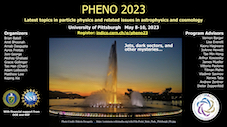Speaker
Description
The black hole images released by the Event Horizon Telescope have opened up a multitude of opportunities to improve our understanding of gravity in strongly curved spacetimes, as well as elucidate the dynamics of turbulent plasma. In this talk, I will connect these two phenomena by demonstrating that the intrinsic variability of reconnection-driven flares in the accretion flow can introduce prominent associated changes in the relative brightness of the lensed emission. Using a combination of numerical and semi-analytic models of flux eruption events, I will show that the “photon ring” formed by multiply imaged emission exhibits a characteristic “loop” in the space of relative brightness versus total flux density. This loop arises from a combination of gravitational lensing, Doppler boosting, and magnetic field structure near the event horizon. I will discuss the ways in which we hope to observe and analyze this feature in supermassive black holes with the next-generation Event Horizon Telescope.

